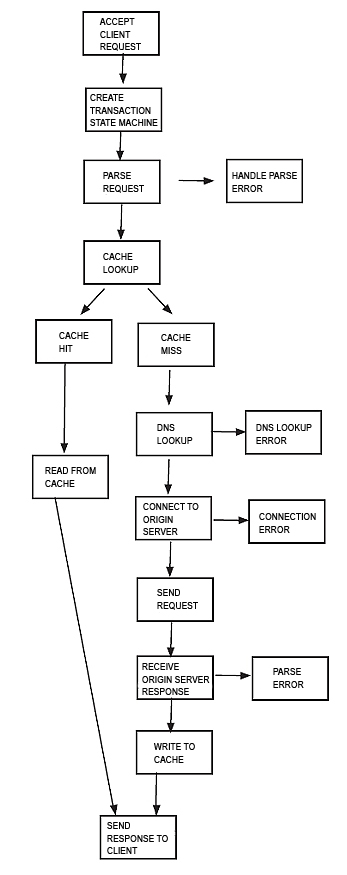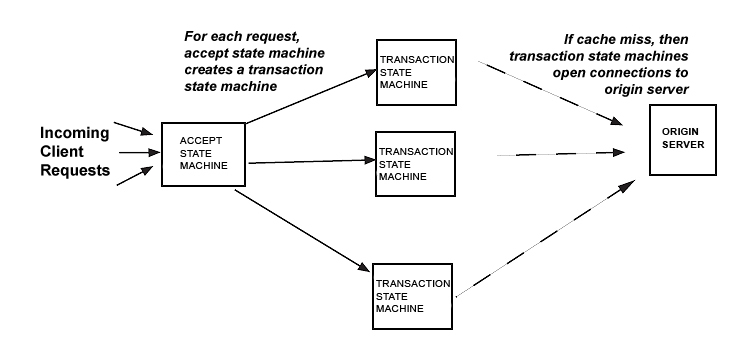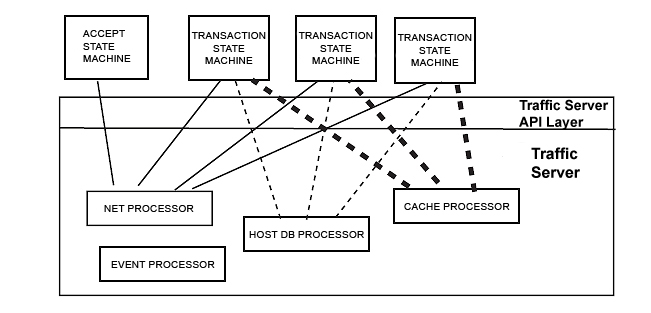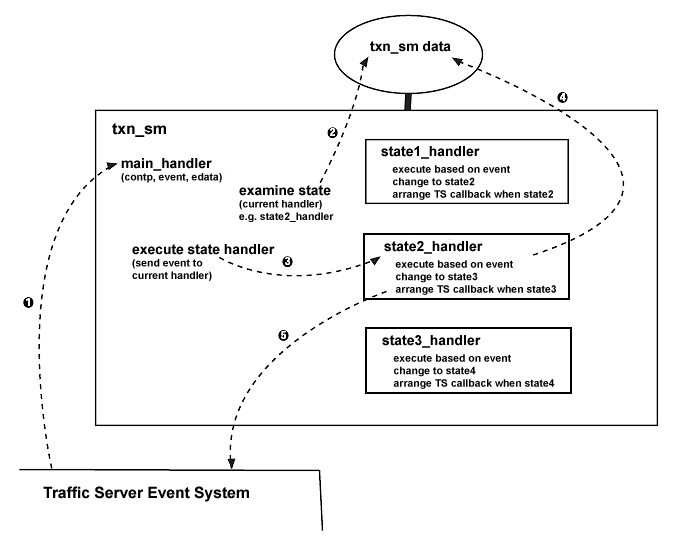新規プロトコルプラグイン
新規プロトコルプラグインは Traffic Server を任意のプロトコルのウェブプロキシーに拡張することを可能にします。この章では新規プロトコル API と新規プロトコルをサポートするプラグインについて説明します。また非常にシンプルな模造の HTTP ライクなプロトコルをサポートするサンプルプロトコルプラグインのコードの詳細なレビューも示します。
サンプルプロトコルについて
サンプルプロトコルはクライアントがサーバーにファイルを問い合わせることを可能にします。クライアントは特定の Traffic Server ポート( plugin.config で指定される)にリクエストを送信します。各リクエストは下記の構造を持ちます。
server_name file_name
Using the Protocol plugin, Traffic Server can accept these requests, parse them, and act as a proxy cache (i.e., request the file from the origin server on the client's behalf and store copies of response messages in cache). The Protocol plugin is a state machine that flows through the states illustrated in the Sample Protocol State Diagram. This figure illustrates the steps that Traffic Server and the Protocol plugin go through in order to support the sample protocol.
より具体的には、 Traffic Server とプロトコルプラグインは下記の処理をする必要があります。:
クライアントコネクションの listen と accept を行う。(サーバーポートは
plugin.configで指定される)やってきたクライアントリクエストを読込む
リクエストされたコンテンツを、 Traffic Server キャッシュ内でルックアップする
リクエストがキャッシュヒットした場合、キャッシュからコンテンツを配信する。(このシンプルな例では新鮮さのチェックを行わない)
リクエストがキャッシュミスした場合、オリジンサーバーとのコネクションを開く。(サーバーポートは
plugin.configで指定される)オリジンサーバーへリクエストを転送する。
オリジンサーバーのレスポンスを受け取る。
レスポンスをキャッシュし、クライアントに送信する。
Sample Protocol State Diagram

サンプルプロトコルの状態遷移図
プロトコルプラグインの構造
To see how the Protocol plugin works, you need to understand some broader concepts. This section assumes you're familiar with the concepts of continuation, Traffic Server's asynchronous event model, and basic Traffic Server plugin structure. If you are not familiar with these concepts, then you may want to begin with the はじめに section.
プロトコルプラグインにおける継続
The Protocol plugin creates a static continuation that is an "accept" state machine - that is, a state machine whose job is to accept client connections on the appropriate port. When Traffic Server accepts a net connection from a client on that port, the accept state machine is activated. It then creates a new continuation: a transaction state machine. The accept state machine creates one transaction state machine for each transaction (where a transaction consists of a client request and Traffic Server's response). Each transaction state machine lives until the transaction completes; then it is destroyed. If the client's request for content is a cache miss, then a transaction state machine might need to open a connection to the origin server. This is illustrated in the Protocol Plugin Overview diagram below.
プロトコルプラグイン概要

プロトコルプラグイン概要
プロトコルプラグインの記述の最初のステップは明確です。 TSPluginInit で、 plugin.config で指定されたクライアントポートでネットコネクションを listen する継続を生成しなければなりません。(この継続は accept ステートマシンです)
下記はプロトコルプラグインの為に実装される継続の概要です:
クライアントコネクションを listen し、 Traffic Server が新しいクライアントコネクションを accept する度にトランザクションステートマシンを生成する accept ステートマシン 。 accept ステートマシンは Traffic Server が動作している限り残ります。
クライアントリクエストを読込み、処理し、トランザクションが終了した際に破棄される トランザクションステートマシン
イベントフロー
Implementing the rest of the Protocol plugin requires that you
understand the flow of events during the course of a transaction. Unlike
HTTP transaction plugins, this plugin must read data from network
connections and then read/write data to the Traffic Server cache. This
means that its continuations do not receive HTTP state machine events;
they receive events from Traffic Server's processor subsystems. For
example: the accept state machine is activated by an
TS_EVENT_NET_ACCEPT event from Traffic Server's Net Processor; the
handler function for the accept state machine must therefore be able to
handle that event.
トランザクションステートマシンはクライアントコネクションがやって来たリクエストデータを受信した際に始動します。 ネットプロセッサー はやって来たデータのトランザクションステートマシンに通知します。トランザクションステートマシンはそのデータを読込み、それが終了した際にリクエストされたファイルのキャッシュルックアップを開始します。キャッシュルックアップが完了した際、トランザクションステートマシンは Traffic Server の キャッシュプロセッサー によって始動します。
トランザクションステートマシンがコンテンツを取得するためオリジンサーバーへのコネクションを開く必要がある場合(キャッシュミスした場合)、トランザクションステートマシンはサーバー名の DNS ルックアップを開始します。トランザクションステートマシンは Traffic Server の ホストデータベースプロセッサー からの DNS ルックアップイベントによって始動します。トランザクションがオリジンサーバーへ接続しなければならない場合、トランザクションステートマシンはネットコネクションを開始し、ネットプロセッサーからのイベントを待ちます。
プロトコルプラグインのイベントのフロー

プロトコルプラグインのイベントのフロー
The flow of events is illustrated in the Protocol Plugin Flow of Events diagram above. The thin straight lines show Net Processor event flow, the thin dashed lines represent Host Database event flow, and the thick dashed lines show Cache event flow.
Notice that this flow of events is independent of the Protocol plugin's
design (i.e., whether you build accept or transaction state
machines). Any plugin that supports network connections uses the net
vconnection interfaces (TSNetAccept(), TSNetConnect()) and thus
receives events from the Net Processor. Any plugin that performs cache
lookups or cache writes uses TSCacheRead(), TSCacheWrite(),
TSVConnRead(), and TSVConnWrite() and thus receives events from the
Cache Processor and Traffic Server event system. Similarly, any plugin
that does DNS lookups receives events from the Host Database Processor.
トランザクションステートマシンを実装する方法の一つ
プロトコルプラグインの トランザクションステートマシン ( TSM )は下記のようにする必要があります。
トランザクションの状態を追跡し続ける
(トランザクションの状態と受け取ったイベントに基づき)受け取ったイベントを処理する
変更があったらトランザクションの状態を更新する
以下は TSM を実装できる方法の一つです。プロトコルプラグインがこれをどう行っているかの詳細は次の節で説明します。
追跡し続ける必要のある全ての状態データを含む、トランザクションのデータ構造を作成する。サンプルのプロトコルプラグインにおいてこれは
Txn_SM構造体。TSM の継続を作成する際、
Txn_SM型のデータを初期化する。データをトランザクションの初期状態に初期化する。(この場合、ネットコネクションはちょうど accept されている)このデータをTSContDataSetを使って TSM 継続に関連付ける。状態ごとに予想されるイベントを処理する、状態ハンドラー関数を記述する。
TSM のハンドラーを記述する。そのジョブはイベントを受け取る、現在の状態を検査する、そして適切な状態ハンドラー関数を実行する。プロトコルプラグインにおいて、そのハンドラーは
main_handlerである。main_handlerは各状態を処理するために状態ハンドラー関数を呼び出す。
The steps below describe the flow of execution illustrated in "How Transaction State Machines are Implemented in the Protocol Plugin".
The handler for the TSM, (called
main_handlerin the Protocol plugin) receives events from the TSM.main_handlerexamines the state of the transaction-in particular, it examines the current handler.main_handlercalls thecurrent_handler(which is one of the state handler functions), and then passes the current event tocurrent_handler. In the image below below, the current handler is calledstate2_handler.The
current_handlerhandles the event and updates the data. In the image below below, the state is changed fromstate2tostate3(and the current handler is changed fromstate2_handlertostate3_handler). The next timemain_handlerreceives an event, it will be processed bystate3_handler.state2_handlerarranges the next callback of the TSM. Typically, it gives Traffic Server additional work to do (such as writing a file to cache) so that it can progress to the next state. The TSM (main_handler) then waits for the next event to arrive from Traffic Server.
How Transaction State Machines are Implemented in the Protocol Plugin

プロトコルプラグインにおいてトランザクションステートマシンがどのように実装されるか
典型的なトランザクションの処理
コードは下記のファイルに含まれます。:
Protocol.ccandProtocol.hTxnSM.ccandTxnSM.h
下記は典型的なトランザクションを処理するコードの、段階的なウォークスルーです。
The
TSPluginInit()function is in theProtocol.ccfile. It checks the validity of theplugin.configentries (there must be two: a client accept port and a server port) and runs an initialization routine,init.The
initfunction (inProtocol.cc) creates the plugin's log file usingTSTextLogObjectCreate().The
initfunction creates the accept state machine usingAcceptCreate. The code forAcceptCreateis in theAccept.ccfile.The
initfunction arranges the callback of the accept state machine when there is a network connection by usingTSNetAccept().The handler for the accept state machine is
accept_handlerin theProtocol.ccfile. When Traffic Server's Net Processor sendsTS_EVENT_NET_ACCEPTto the accept state machine,accept_handlercreates a transaction state machine (txn_sm) by callingTxnSMCreate. Notice thataccept_eventcreates a mutex for the transaction state machine, since each transaction state machine has its own mutex.The
TxnSMCreatefunction is in theTxnSM.ccfile. The first thing it does is initialize the transaction's data, which is of typeTxnSM(as defined inTxnSM.h). Notice that the current handler (q_current_handler) is set tostate_start.TxnSMCreatethen creates a transaction state machine using :func`TSContCreate`. The handler for the transaction state machine ismain_handler, which is in theTxnSM.ccfile.When
accept_eventreceivesTS_EVENT_NET_ACCEPT, it calls the transaction state machine (TSContCall (txn_sm, 0, nullptr);). The event passed tomain_handleris0(TS_EVENT_NONE).The first thing
main_handlerdoes is examine the currenttxn_smstate by callingTSContDataGet(). The state isstate_start.main_handlerthen invokes the handler forstate_startby using the function pointerTxnSMHandler(as defined inTxnSM.h).The
state_starthandler function (in theTxnSM.ccfile) is handed an event (at this stage, the event isTS_EVENT_NET_ACCEPT) and a client vconnection.state_startchecks to see if this client vconnection is closed; if it is not, thenstate_startattempts to read data from the client vconnection into anTSIOBuffer(state_startis handling the event it receives).state_startchanges the current handler tostate_interface_with_client(that is, it updates the state of the transaction to the next state).state_startinitiates a read of the client vconnection (arranges for Traffic Server to sendTS_EVENT_VCONN_READ_READYevents to the TSM) by callingTSVConnRead().state_interface_with_clientis activated by the next event from Traffic Server. It checks for errors and examines the read VIO for the read operation initiated byTSVConnRead().If the read VIO is the
client_read_VIO(which we are expecting at this stage in the transaction), thenstate_interface_with_clientupdates the state tostate_read_request_from_client.state_read_request_from_clienthandles actualTS_EVENT_VCONN_READ_READYevents and reads the client request.state_read_request_from_clientparses the client request.state_read_request_from_clientupdates the current state to the next state,state_handle_cache_lookup.state_read_request_from_clientarranges for Traffic Server to call back the TSM with the next set of events (initiating the cache lookup) by callingTSCacheRead().When the
TSCacheRead()sends the TSM eitherTS_EVENT_CACHE_OPEN_READ(a cache hit) orTS_EVENT_CACHE_OPEN_READ_FAILED(a cache miss),main_handlercallsstate_handle_cache_lookup.